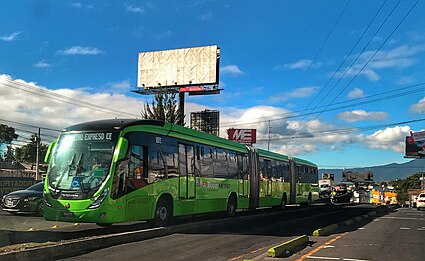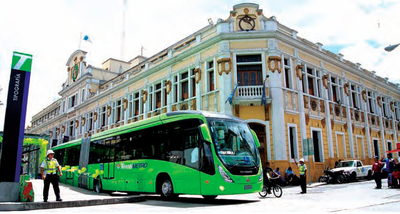
Guatemala City, formally New Guatemala of Assumption and the Ancient, known locally as Guate, is the capital and largest city of Guatemala, and the most populous urban area in Central America. The city is located in the south-central part of the country, nestled in a mountain valley called Valle de la Ermita. The city is also the capital of the Guatemala Department.

The Massachusetts Bay Transportation Authority is the public agency responsible for operating most public transportation services in Greater Boston, Massachusetts. The MBTA transit network includes the MBTA subway with three metro lines, two light rail lines, and a five-line bus rapid transit system ; MBTA bus local and express service; the twelve-line MBTA Commuter Rail system, and several ferry routes. In 2022, the system had a ridership of 216,329,500, or about 778,600 per weekday as of the third quarter of 2023, of which the rapid transit lines averaged 283,900 and the light rail lines 101,300, making it the fourth-busiest rapid transit system and the third-busiest light rail system in the United States. As of the third quarter of 2023, average weekday ridership of the commuter rail system was 92,400, making it the fifth-busiest commuter rail system in the U.S.
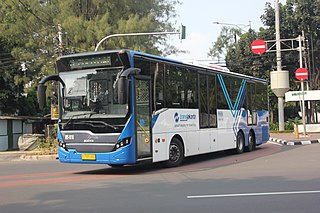
Bus rapid transit (BRT), also referred to as a busway or transitway, is a bus-based public transport system designed to have much more capacity, reliability and other quality features than a conventional bus system. Typically, a BRT system includes roadways that are dedicated to buses, and gives priority to buses at intersections where buses may interact with other traffic; alongside design features to reduce delays caused by passengers boarding or leaving buses, or paying fares. BRT aims to combine the capacity and speed of a light rail transit (LRT) or mass rapid transit (MRT) system with the flexibility, lower cost and simplicity of a bus system.

TransMilenio is a bus rapid transit (BRT) system that serves Bogotá, the capital of Colombia, and Soacha. The system opened to the public in December 2000. As of 2022, 12 lines totalling 114.4 km (71 mi) run throughout the city. It is part of the city's Integrated Public Transport System, along with the urban, complementary and special bus services operating on neighbourhoods and main streets.

Calgary Transit is the public transit agency which is owned and operated by the city of Calgary, Alberta, Canada. In 2019, an estimated 106.5 million passengers boarded approximately 1,155 Calgary Transit vehicles. It operates light metro (LRT), urban tramway, bus rapid transit (BRT), para-transit, and regular bus services. In 2022, the system had a ridership of 103,306,500, or about 421,000 per weekday as of the third quarter of 2023.

The Société de transport de Montréal is a public transport agency that operates transit bus and rapid transit services in the urban agglomeration of Montreal, Quebec, Canada. Established in 1861 as the "Montreal City Passenger Railway Company", it has grown to comprise four subway lines with a total of 68 stations, as well as 212 bus routes and 23 night routes. The STM was created in 2002 to replace the Société de transport de la communauté urbaine de Montréal. The STM operates the most heavily used urban mass transit system in Canada, and one of the most heavily used rapid transit systems in North America. As of 2019, the average daily ridership is 2,297,600 passengers: 977,400 by bus, 1,306,500 by rapid transit and 13,700 by paratransit service.
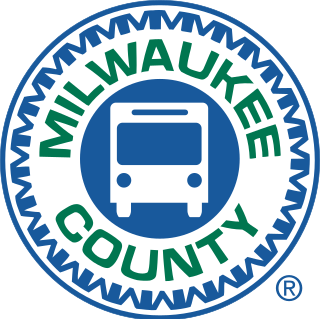
The Milwaukee County Transit System (MCTS) is the largest transit agency in Wisconsin, and is the primary transit provider for Milwaukee County. It ranks among the top 50 transit agencies in the United States for total passenger trips. Milwaukee Transport Services, Inc. is a quasi-governmental agency responsible for the management and operation of the Milwaukee County Transit System. Its bus fleet consists of 360 buses. In 2022, the system had a ridership of 15,914,000, or about 57,400 per weekday as of the third quarter of 2023.

The Interurban Transit Partnership, branded as The Rapid, is the public transit operator serving Grand Rapids, Michigan and its suburbs. In 2022, the system had a ridership of 5,106,600, or about 19,800 per weekday.

The Emerald Express (EmX) is a bus rapid transit (BRT) system in the Eugene-Springfield metropolitan area in Oregon, United States. It is provided by the Lane Transit District (LTD) which is the public transit authority in Lane County, Oregon.

MAX is a bus rapid transit (BRT) service operated by Utah Transit Authority (UTA) along the Wasatch Front in Utah, United States. It is described by UTA as "light rail on rubber tires." As of August 2023 there is one line in service in Utah County, one line in service in Weber County, one discontinued line in Salt Lake County, and two new routes planned for Salt Lake County.

Servicio de Transportes Eléctricos de la Ciudad de México (STE) is a public transport agency responsible for the operation of all trolleybus and light rail services in Mexico City. As its name implies, its routes use only electrically powered vehicles. It was created on 31 December 1946 and is owned by the Mexico City government. STE is overseen by a broader local governmental authority, Secretaria de Movilidad de la Ciudad de México (SEMOVI)(Secretariat of Mobility of Mexico City), formerly (SETRAVI) which also regulates the city's other public transport authorities, including Sistema de Transporte Colectivo, Red de Transporte de Pasajeros del Distrito Federal and Metrobús, as well as other forms of transportation in the district. STE's passenger vehicle fleet consists exclusively of trolleybuses, light rail, and aerial lift vehicles, and in 2007 its network carried 88 million passengers, of which 67 million were on trolleybus services and 21 million on light rail.

Metro is a transit network in Minnesota serving the cities of Minneapolis and Saint Paul. It also provides service to some suburban areas. As of 2022, the system consists of two light rail lines and five bus rapid transit (BRT) lines all of which are operated by the local public transit company: Metro Transit. The five lines connect Downtown Minneapolis and St Paul with the Bloomington, Minneapolis-St Paul International Airport, Roseville, Richfield, Burnsville and Brooklyn Center.

The Silver Line is a bus rapid transit line run by the Interurban Transit Partnership in Grand Rapids, Michigan, United States. The line runs along Division Avenue on the Wyoming-Kentwood border into downtown Grand Rapids, where it loops around before terminating at Rapid Central Station. It began operation on August 25, 2014.
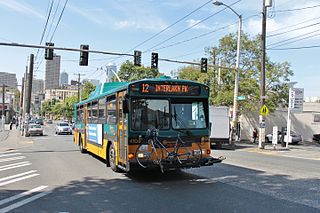
The RapidRide G Line is a future RapidRide bus service in Seattle, Washington, operated by King County Metro on Madison Street between Downtown Seattle and Madison Valley. The line is projected to open for service in 2024 and cost $133.4 million.

The Metro B Line is an under construction bus rapid transit route in Minneapolis and St. Paul. The route will operate mostly on Lake Street in Minneapolis before crossing the Mississippi River into St. Paul and operating mostly on Selby Avenue and ending in downtown St. Paul. The route was identified in Metro Transit's 2014 Arterial Transitway Corridors Study as one of eleven local routes to be upgraded to bus rapid transit. The route will have "train-like" features to speed up service, such as signal priority, all-door boarding, further stop spacing, and specialized vehicles. Planning and design was completed in 2021, with construction beginning in May 2023. The line will join a number of Metro Transit's future Metro system lines, as well as the currently operating A Line, C Line, and D Line. Full funding for the line was secured in October 2020 with a final $35 million from the state of Minnesota.

CMAX is a bus rapid transit (BRT) service in Central Ohio, operated by the Central Ohio Transit Authority (COTA). The line begins in Downtown Columbus, traveling northeast to Westerville. CMAX is Central Ohio's first bus rapid transit line; it began operation in 2018.
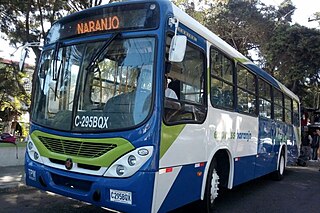
The Rutas Express Guatemala, is an Express Public Transit system that operates from the Mixco Municipality, west of Guatemala City. This service serves local residents in Mixco and the South-west end of Guatemala City, and provides some connections to Transmetro lines. Mixco is the third most populous city in the metropolitan region surrounding Guatemala City, and was severely under served by public transit from private operators in recent years.
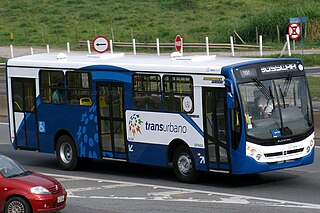
The Transurbano is a public bus system that serves Guatemala City. The system is operated by Siga, and funded by the government of Guatemala. The project was inaugurated during the administration of ex-president Alvaro Colom, and was supported by the Asociación de Empresarios de Autobuses Urbanos. The system was established with the goal of replacing privately operated bus service in Guatemala City, eventually amalgamating all urban bus services under the Transurbano umbrella. Service officially began on July 3, 2010, with 15 buses covering 3 routes operating in the southern part of the city between Zone 12 and Zone 21.

Transpinula is a BRT system in Santa Catarina Pinula, Guatemala. The first two lines opened on January 29, 2022. The fleet consists of modern Torino G7 Volvo buses made by Marcopolo in Brazil. The buses have fixed stops and mostly operate in mixed-traffic. Both stops and vehicles are guarded by municipal police. The stations are much smaller compared to the Transmetro stations in neighbouring Guatemala City. However they are elevated so as to be level with the floor of the bus. Passengers may access stations via stairs or ramps and the stations feature glass walls protecting passengers from the edge of the platforms. Security is provided by Santa Catarina Pinula's transit police. Officers in yellow vests are situated at most stations on the route.




